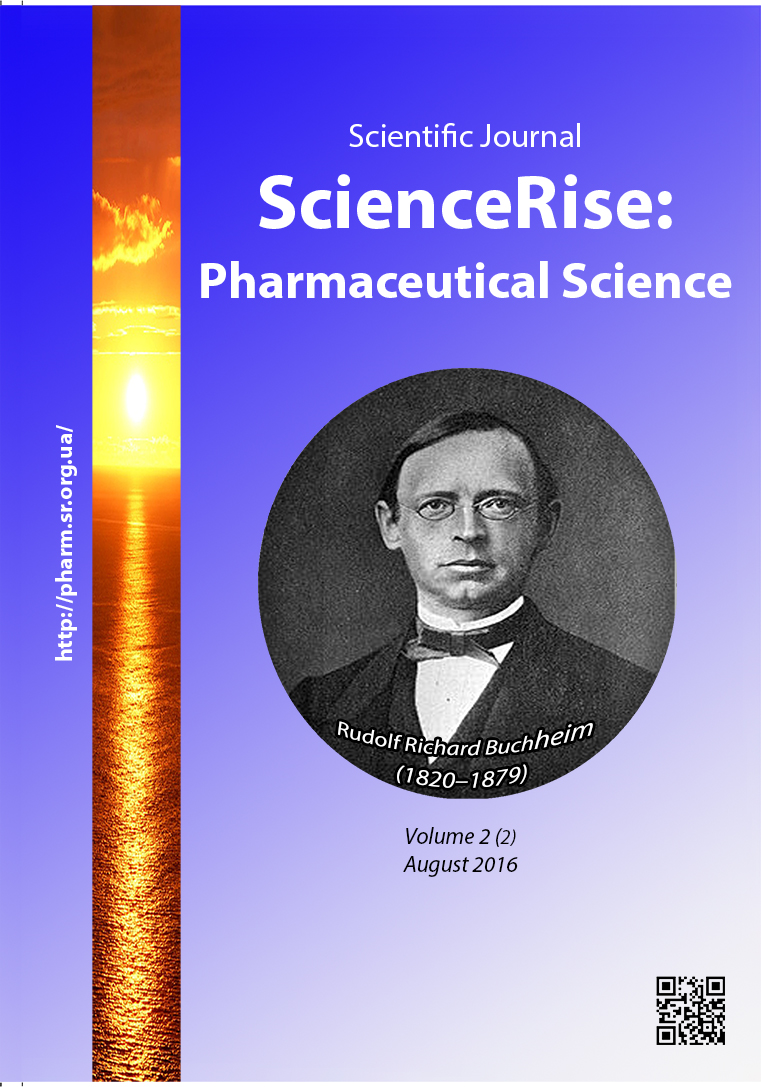The analysis of Hosta lancifolia rhizomes with roots, leaves and flowers fatty acid
DOI:
https://doi.org/10.15587/2519-4852.2016.75073Keywords:
gas chromatography, fatty acid, Hosta lancifolia, qualitative determination, quantitative analysisAbstract
Hosta is a perennial ornamental plant used in Eastern folk medicine for the treatment of inflammatory diseases of the upper respiratory tract in particular coughs and pharyngolaryngeal, folliculitis, mastitis, urethritis, bruises and dysmenorrhea.
The aim of the research was the study of the qualitative composition and quantitative content of fatty acids in rhizomes with roots, leaves, and flowers of Hosta lancifolia.
Materials and methods. The fatty acid composition of the rhizomes with roots, leaves and flowers of Hosta lancifolia was studied by gas chromatography, which is based on the formation of methyl esters of fatty acids and their subsequent determination.
The results of the study and their discussion. As the result of the study 16 fatty acids, 13 which of them were identified were collectively determined in all types of plant raw material. Unsaturated fatty acids quantitatively dominated in all types of plant raw material. Their total content in the rhizomes with roots were 73.82 %, in the leaves, - 64.9%, and in the flowers of Hosta lancifolia their content was 69.15 %.
In Hosta lancifolia rhizomes with roots, leaves, and flowers linoleic and palmitic fatty acids were accumulated in significant amount. In addition, there was observed a high content of oleic acid – 20.63 % in rhizomes and roots. Linolenic acid mainly accumulated in flowers – 38.78 %. Oleic and arachidonic acids were detected in leaves at the significant amount. Their contents were almost identical and consistent with 15.15 % and 15.83 %. Eicosanic, begenic and lignocerinic fatty acids in all the investigated plant raw materials waere accumulated in small amount and their content was less than 1.00 %.
Conclusion. Hosta lancifolia contains a considerable number of unsaturated fatty acids in rhizomes with roots, leaves, and flowers. The dominant acids in all the investigated raw materials were palmitic and linoleic acids, and the content of eicosanic, begenic and lignocerinic fatty acids was less than 1.00 %
References
- Boiko, I. V. (2008). Istoriia introduktsii ta systematychne polozhennia rodu Hosta Tratt. Introduktsiia roslyn, 3, 18–21.
- Mironova, L. N., Reut, A. A. (2015). Hostyi dlya zelenogo stroitelstva na Yujnom Urale. Vestnik Udmurtskogo universiteta, 25 (2), 51–57.
- Himina, N. I. (2005). Hostyi. Moscow: Kladez – Buks, 95.
- Liu, Q., Sun, G., Wang, S., Lin, Q., Zhang, J., Li, X. (2014). Analysis of the variation in scent components of Hosta flowers by HS-SPME and GC–MS. Scientia Horticulturae, 175, 57–67. doi: 10.1016/j.scienta.2014.06.001
- Liu, N., Sun, G., Xu, Y., Luo, Z., Lin, Q., Li, X. et. al. (2013). Anthocyanins of the genus of Hosta and their impacts on tepal colors. Scientia Horticulturae, 150, 172–180. doi: 10.1016/j.scienta.2012.10.030
- Li, R. (2012). Chemical constituents and biological activities of genus Hosta (Liliaceae). Journal of Medicinal Plants Research, 6 (14). doi: 10.5897/jmpr11.1123
- Kim, C. S., Kwon, O. W., Kim, S. Y., Lee, K. R. (2014). Flavonoid Glycosides fromHosta longipes, Their Inhibition on NO Production, and Nerve Growth Factor Inductive Effects. Journal of the Brazilian Chemical Society. doi: 10.5935/0103-5053.20140060
- Yada, H., Kimura, T., Suzuki, M., Ohnishi-Kameyama, M., Shinmoto, H. (2010). New Steroidal Saponin fromHosta sieboldiana. Bioscience, Biotechnology, and Biochemistry, 74 (4), 861–864. doi: 10.1271/bbb.90807
- Cherepanov, S. K. (1995). Sosudistyie rasteniya Rossii i sopredelnyih gosudarstv. Sankt-Peterburg, 524.
- Wang, J.-S., Liu, H.-Y., Li, C.-S., Di, Y.-T., Li, S.-L., He, H.-P. (2014). Patent No. CN 201310584941. Application of hosta plantaginea flower water extract to cigarettes. No. CN 103549640 A, declared: 20.11.2013; published: 05.02.2014.
- Demeshko, O. V., Kovalov, S. V., Myhal, A. V. (2012). Vyvchennia lipofilnykh spoluk albitsii lenkoranskoi. Farmatsevtychnyi chasopys, 3, 35–38.
- Oshytko, R. V., Hrytsyk, A. R. (2012). Vyvchennia zhyrnokyslotnoho skladu nasinnia hlodu odnomatochkovoho (Crataegus monogyna) ta hlodu zghladzhenoho (Crataegus laevigata) i perspektyvy zastosuvannia zhyrnoi olii hlodiv u medytsyni. Farmakolohiia ta likarska toksykolohiia, 1 (26), 48–53.
- Sedelnikova, L. L., Kukushkina, T. A. (2015). Biologicheski aktivnyie veschestva vegetativnyih organov Hosta lancifolia Engl. (Hostaceae). Himiya rastitelnogo syirya, 3, 199–204. doi: 10.14258/jcprm.201503562
- Musienko, S. G., Kislichenko, V. S. (2012). Zhirnokislotniy sklad sirovini lavru blagorodnogo. Ukrayinskiy medichniy almanah, 15 (6), 119–120.
Downloads
Published
How to Cite
Issue
Section
License
Copyright (c) 2016 Вікторія Василівна Процька, Олександра Анатоліївна Кисличенко, Ірина Олександрівна Журавель

This work is licensed under a Creative Commons Attribution 4.0 International License.
Our journal abides by the Creative Commons CC BY copyright rights and permissions for open access journals.








